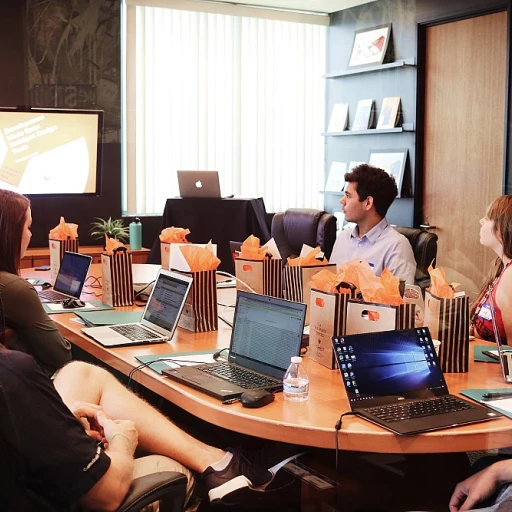
Understanding Advanced Skills Management
Diving Deep into Skills Management for the Future Workforce
In the rapidly evolving landscape of work, understanding and mastering skills management has never been more critical. For organizational leaders, human resources specialists, and employees alike, advanced skills management forms the backbone of adapting to future workplace demands. As we usher in an era where technology and human expertise must coexist and complement one another, having a structured system in place becomes essential.
Organizations, including renowned entities like the United States Navy, have long implemented rigorous skills assessments and training programs to ensure their personnel are prepared for both current and future demands. This strategic approach serves as a blueprint for other sectors as workforce dynamics transform globally. Integrated training programs focus on bridging skill gaps, ensuring both individuals and teams are equipped with essential skills required for modern challenges.
Advanced skills management not only involves understanding current capabilities but also predicting future needs. Navy mil programs, for instance, highlight the importance of continuous skill growth and adaptability in environments such as mine warfare. By embracing lifelong learning, employees can stay ahead of industry shifts, ensuring their long-term career development.
Additionally, the rise of technology-driven training and learning systems, such as advanced online platforms and video modules, further underscores the importance of adaptable career management strategies. These systems support workforce development by offering flexible, on-demand training solutions that cater to varied learning preferences.
As team members work on projects spanning diverse fields such as command and control or project management, advanced skills and continuous learning become intertwined. Organizations that prioritize comprehensive skills management programs empower their employees, facilitating leadership and innovation across all levels. Through effective skills management, organizations can enhance their employees' leadership capabilities, creating a more dynamic and prepared workforce.
For more insights on cutting-edge training strategies and comprehensive workforce planning tools, explore the innovative skill development strategies for the future of work.
The Role of Technology in Skills Development
The Influence of Technological Evolution on Skill Development
In the modern workplace, technology acts as a robust catalyst, transforming how individuals and teams approach advanced skills. As organizations across the globe, including the United States Navy personnel, explore more efficient operations, the integration of technology into skills management has become paramount. This not only reshapes how workforce skills are honed but also how they are accessed and implemented within daily operations.
The adoption of online training programs and video-based learning has democratized access to knowledge, enabling employees to gain essential skills at their own pace. For instance, the implementation of a centralized management system empowers personnel to engage in continuous learning without the constraints of traditional classroom settings. The flexibility fostered by such systems is evident even in specialized areas like mine warfare, where real-time skill updates are crucial.
Moreover, technology enhances skills assessment, offering analytical insights to identify skill gaps. Leveraging data-driven approaches, organizations can tailor their training initiatives to meet evolving demands. Such methodologies also facilitate improved career management pathways, ensuring an alignment between individual aspirations and organizational goals.
By harnessing technology in skill development, management skills such as project management and team command can be cultivated more effectively. It empowers leadership to mentor team members, driving a culture of enhanced productivity and innovation. For more on how technology is chicly shaping skillful workplaces, consider exploring the impactful dynamics of future workforces in this article.
Adapting to Rapid Change: A Skill in Itself
Embracing Change as a Core Competency
In today's rapidly evolving work environment, adaptability has emerged as an essential skill. As industries and technologies transform, the ability to pivot and embrace new methodologies becomes crucial. The art of skill adaptation is not just about acquiring new skills, but also about developing a mindset that thrives on change.
Organizations, like the United States Navy, exemplify this need for adaptability. With a focus on advanced skills management, navy personnel are trained to adjust to new technologies and strategies, ensuring they remain effective in diverse scenarios. This approach is mirrored in various sectors where continuous learning and development are prioritized to bridge skill gaps.
For employees, adapting to rapid change involves:
- Engaging in continuous learning programs that emphasize both technical and soft skills development.
- Participating in online training and workshops to stay updated with industry trends and advanced management techniques.
- Collaborating with team members to foster a culture of shared knowledge and innovation.
Leadership plays a pivotal role in facilitating this adaptability. By promoting a culture of openness and encouraging employees to take on new challenges, leaders can ensure that their teams are not just reacting to change, but are proactively shaping their career paths.
Moreover, tools like advanced management systems and skills assessments help organizations measure the impact of skill development initiatives. These systems provide insights into the return on investment for training programs and help identify areas where further development is needed.
Ultimately, the ability to adapt to rapid change is a skill in itself, one that requires a commitment to lifelong learning and a proactive approach to career management. As we navigate the future of work, embracing change will be key to maintaining a competitive edge in the workforce.
Continuous Learning: The New Norm
Embedding Learning as Part of the Corporate DNA
In today's ever-evolving workplace, continuous learning is not just an aspiration but a necessity. As the pace of technological advancements accelerates, the demand for advanced skills grows in tandem, making the need for ongoing training and development more vital than ever. To effectively manage this within organizations like the United States Navy and other sectors, continuous learning demonstrates itself as a fundamental backdrop for keeping skills relevant.
Continuous learning in the workforce often involves a robust management system that incorporates both online and in-person training programs. Integrating these elements helps align the organization's career development goals with individual aspirations, fostering a mutually beneficial growth environment. Team members benefit from structured learning paths, supported by leadership dedicated to nurturing a culture that prioritizes skill advancement.
The trick lies in instituting an adaptable learning structure that surprises employees with dynamic training interventions fashioned to close skill gaps. Advanced management techniques that blend video training, real-world scenarios, and interactive learning materials can escalate skills development. For example, navy personnel undergoing mine warfare training can have tailored programs to enhance both technical and managerial capabilities.
Career management within this framework transcends mere skill acquisition, delving into long-term objectives of increased engagement and retention. Building these programs relies heavily on feedback and frequent skills assessments to ensure continuous improvement aligns with the broader goals of personnel command.
Ultimately, organizations must realize that continuous learning, anchored by robust systems and leadership support, steers them toward sustainable adaptability, a skill in itself. By embedding learning as part of corporate DNA, teams are more agile and prepared to tackle future challenges effectively.
Building a Culture of Skill Growth
Fostering a Growth Mindset Among Teams
In order to truly harness the power of skill adaptation in the future workplace, building a culture that embraces continuous skill development is critical. As organizations, including the navy, pivot towards more advanced training and career management systems, instilling an environment that promotes learning from every level is vital.Training isn't just a one-time event but a continuously evolving aspect of workplace culture. Employees are encouraged to engage with career development systems and advanced skills programs designed to fill skill gaps. From navy personnel to technology firms, fostering a workforce driven by skill acquisition requires a sweeping mindset shift.
- Encouragement from Leadership: Modern management must lead by example. When command teams prioritize learning and development as a fundamental business strategy, employees are more likely to follow suit. Leadership must regularly communicate the importance of skill growth and management skills development.
- Incorporating Online Learning Resources: With advances in online training, employees can access development resources at their convenience. Whether watching videos on advanced skills techniques or participating in webinars about career management, integrating online systems creates a flexible learning environment adaptable to the needs of the 21st-century employee.
- Structure for Continuous Feedback: Implement regular skills assessments to offer insights into the development journey. Feedback mechanisms should involve team members discussing essential skills, addressing skill gaps, and collaborating on personalized development plans.
The emphasis on growth should not only be on immediate skill application but also long-term career development. A robust system, akin to the navy mil personnel command, can provide structure, but the onus remains on employees to proactively engage with available resources.
Finally, creating an empowering environment centered on skill growth not only advances organizational goals but also enriches employee command over their careers, leading to more motivated, dedicated personnel. This dynamic workforce is prepared to adapt to rapid changes and challenges, fortifying an organization's competitive edge in a fluctuating market.
Measuring Skill Impact and ROI
Quantifying the Value of Skill Development
In the evolving landscape of the future workplace, understanding the tangible impact of advanced skills development on organizational performance is crucial. Companies must learn to systematically assess the effectiveness of their training and development programs. A robust skills management system should not only track progress but offer metrics for evaluating the return on investment (ROI) of these initiatives.
One way to gauge the success of skills development is through skills assessment frameworks that identify skill gaps within the team. Regularly assessing these gaps helps in aligning training efforts with strategic goals, ensuring that employees' career development aligns with organizational needs. This approach is akin to the Navy personnel command’s dedication to aligning training with the overarching mission, such as in specialized fields like mine warfare.
Advanced management systems can offer insights into how newly acquired skills enhance productivity. Leadership teams, therefore, should focus on quantifiable improvements, such as increased efficiency, enhanced project management capabilities, and superior problem-solving within their workforce. Leveraging technology, like video-based online training programs, facilitates not just skill acquisition but also offers analytics on training outcomes.
Furthermore, implementing continuous feedback mechanisms from online articles and other learning systems boosts the adaptability of the program. Feedback loops allow for adjustments in real time, increasing the efficacy of advanced skills management. As organizations, from navy personnel to tech industries, strive to innovate, integrating these advanced systems ensures that skills development translates into quantifiable success.
Measuring the ROI of skill development initiatives isn’t just about financial gain. It extends to career management and career advancement for employees, fostering a long-term commitment to growth. By thoroughly understanding the impact of advanced skills on the workforce, organizations can better navigate the demands of tomorrow’s work environment.












